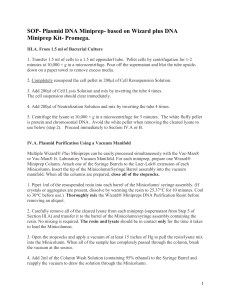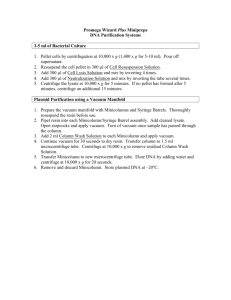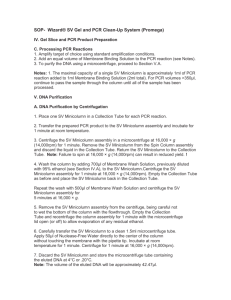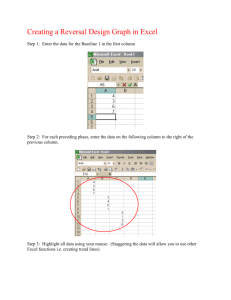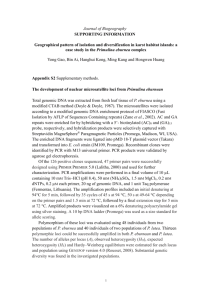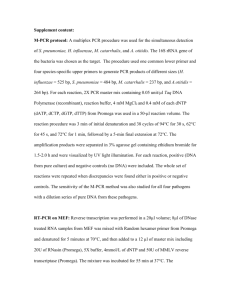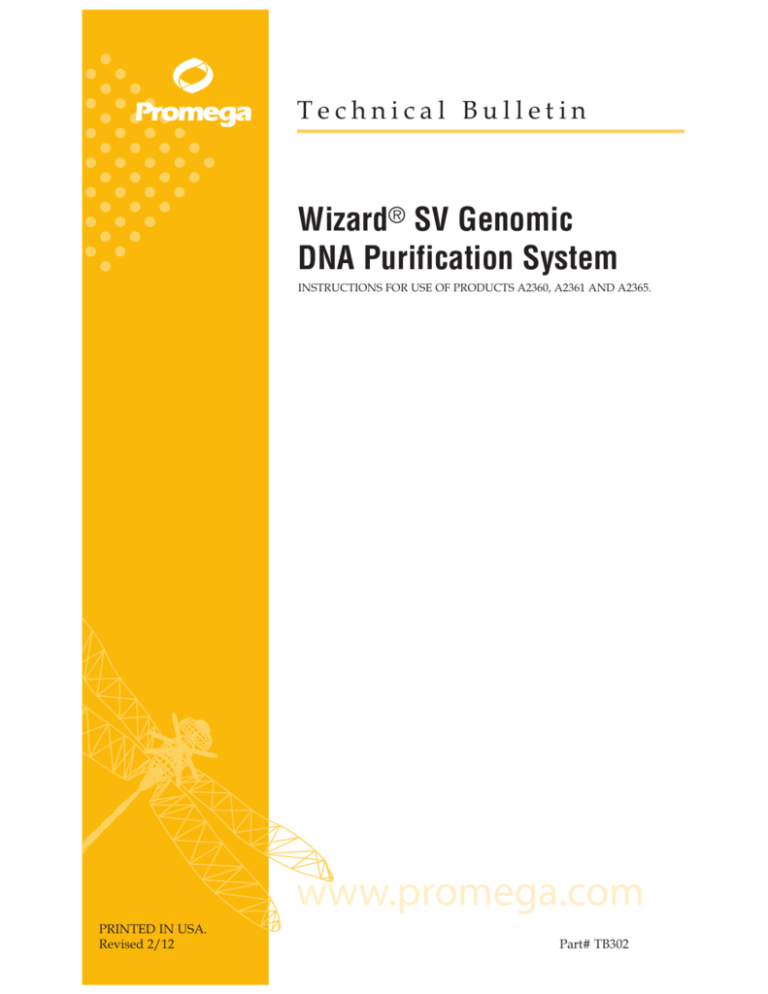
Technical Bulletin
Wizard® SV Genomic
DNA Purification System
INSTRUCTIONS FOR USE OF PRODUCTS A2360, A2361 AND A2365.
PRINTED IN USA.
Revised 2/12
Part# TB302
Wizard® SV Genomic
DNA Purification System
All technical literature is available on the Internet at www.promega.com/protocols
Please visit the web site to verify that you are using the most current version of this
Technical Bulletin. Please contact Promega Technical Services if you have questions on use
of this system. E-mail techserv@promega.com.
1. Description ..........................................................................................................1
2. Product Components and Storage Conditions.............................................3
3. Isolation of Genomic DNA from Mouse Tail Clippings
or Animal Tissues ..............................................................................................4
A.
B.
C.
D.
Preparation of Solutions ...................................................................................................4
Preparation of Mouse Tail and Tissue Lysates ............................................................5
Purification of Genomic DNA from Lysates Using a Microcentrifuge ...................6
Purification of Genomic DNA from Lysates Using a Vac-Man® Vacuum
Manifold ..............................................................................................................................7
4. Isolation of Genomic DNA from Tissue Culture Cells .............................8
A. Preparation of Solutions ...................................................................................................8
B. Preparation of Tissue Culture Cell Lysates ..................................................................8
C. Purification of Genomic DNA from Tissue
Culture Cell Lysates Using a Microcentrifuge .............................................................9
D. Purification of Genomic DNA from Tissue Culture Cell Lysates
Using a Vac-Man® Vacuum Manifold .........................................................................10
5. Troubleshooting ...............................................................................................12
6. Related Products...............................................................................................15
1.
Description
The Wizard® SV Genomic DNA Purification System provides a fast, simple technique for
the preparation of purified and intact DNA from mouse tails, tissues and cultured cells in as
little as 20 minutes, depending on the number of samples processed. For this system, either
a spin or vacuum (“SV”) purification protocol can be used (Figure 1). Up to 20mg of tissue
(mouse tail or animal tissue) or between 1 × 104 and 5 × 106 tissue culture cells can be
processed per purification. The genomic DNA isolated with this system is of high quality
and serves as an excellent template for agarose gel analysis, restriction enzyme digestion
and PCR analysis. Table 1 provides typical yields of genomic DNA purified from a variety
of sources.
Promega Corporation · 2800 Woods Hollow Road · Madison, WI 53711-5399 USA
Toll Free in USA 800-356-9526 · Phone 608-274-4330 · Fax 608-277-2516 · www.promega.com
Printed in USA.
Revised 2/12
Part# TB302
Page 1
Genomic DNA
Purification from
Mouse Tail Clipping
or Tissue Sample
Mouse tail clipping
or tissue sample
Proteinase K
(Cat.# V3021)*
digestion in
Digestion Solution.
Genomic DNA
Purification from
Tissue Culture Cells
Wash tissue
culture cells
with 1X PBS.
Incubate at 55°C
overnight
(16–18 hours).
Add Wizard®
SV Lysis Buffer.
Add Wizard®
SV Lysis Buffer.
Transfer lystate to minicolumn.
Centrifuge.
Vacuum Adapter
(Cat.# A1331)*
Vac-Man®
Laboratory
Vacuum Manifold
(Cat.# A7231)*
Bind DNA.
Wash, removing
solution by
centrifugation
or vacuum.
Transfer spin
column to a 1.5ml
microcentrifuge
tube (not provided).
Centrifuge.
3643MA02_2A
Elute genomic DNA.
Figure 1. Overview of the Wizard® SV Genomic DNA Purification spin and vacuum
protocols. *May be purchased separately.
Promega Corporation · 2800 Woods Hollow Road · Madison, WI 53711-5399 USA
Toll Free in USA 800-356-9526 · Phone 608-274-4330 · Fax 608-277-2516 · www.promega.com
Part# TB302
Page 2
Printed in USA.
Revised 2/12
Table 1. Genomic DNA Yield From Various Tissues.
Sample
Amount
Average Yield
Tail Clipping
20mg
20µg
Liver
20mg
15µg
Heart
20mg
10µg
Brain
20mg
6µg
CHO cells
1 × 106 cells
5µg
NIH3T3 cells
1 × 106 cells
9µg
293 cells
1 × 106 cells
8µg
2.
Product Components and Storage Conditions
Product
Wizard® SV Genomic DNA Purification System
Includes:
•
•
•
•
•
•
•
•
1
1
5ml
1ml
5ml
50ml
250µl
13ml
1
1
50ml
30ml
50ml
185ml
250µl
2 × 25ml
Cat.#
A2365
Size
50 preps
Cat.#
A2360
Wizard® SV Minicolumns (pack of 10)
Collection Tubes (pack of 10)
Nuclei Lysis Solution
0.5M EDTA (pH 8.0)
Wizard® SV Lysis Buffer
Column Wash Solution (CWA; concentrated)
RNase A Solution
Nuclease-Free Water
Product
Wizard® SV Genomic DNA Purification System
Includes:
•
•
•
•
•
•
•
•
Size
10 preps
Wizard® SV Minicolumns (pack of 50)
Collection Tubes (pack of 50)
Nuclei Lysis Solution
0.5M EDTA (pH 8.0)
Wizard® SV Lysis Buffer
Column Wash Solution (CWA; concentrated)
RNase A Solution
Nuclease-Free Water
Promega Corporation · 2800 Woods Hollow Road · Madison, WI 53711-5399 USA
Toll Free in USA 800-356-9526 · Phone 608-274-4330 · Fax 608-277-2516 · www.promega.com
Printed in USA.
Revised 2/12
Part# TB302
Page 3
2.
Product Components and Storage Conditions (continued)
Product
Wizard® SV Genomic DNA Purification System
Includes:
•
1
•
1
•
50ml
•
30ml
• 2 × 50ml
• 2 × 185ml
• 2 × 1ml
•
150ml
Size
250 preps
Cat.#
A2361
Wizard® SV Minicolumns (pack of 250)
Collection Tubes (pack of 250)
Nuclei Lysis Solution
0.5M EDTA (pH 8.0)
Wizard® SV Lysis Buffer
Column Wash Solution (CWA; concentrated)
RNase A Solution
Nuclease-Free Water
Storage Conditions: Store all Wizard® SV Genomic DNA Purification System
components at 22–25°C. See system label for expiration date.
!
3.
Note: If purifying genomic DNA from tissue samples, such as mouse tails,
proteinase K must be purchased separately. For a total of 10 preps, 4mg of
proteinase K is required, for 50 preps, 20mg of proteinase K is required and for
250 preps, 100mg of proteinase K is required.
Isolation of Genomic DNA from Mouse Tail Clippings
or Animal Tissues
Materials to Be Supplied by the User
• Proteinase K (20mg/ml solution in nuclease-free water) (Cat.# V3021 or Sigma
Cat.# P2308). Note: Proteinase K must be qualified as nuclease-free.
• 55°C heat block or water bath
• 1.5ml microcentrifuge tubes
• microcentrifuge capable of 13,000 × g or Vac-Man® Laboratory Vacuum
Manifold (Cat.# A7231), Vacuum trap for waste collection (e.g., Fisher Cat.#
10-182-50B, 1L size), a vacuum pump capable of 15–20 inches of Hg (e.g.,
Fisher Cat.# 01-092-29), vacuum tubing, and Miniprep Vacuum Adapters for
the Vac-Man® Vacuum Manifold (Cat.# A1331).
• single pipettors capable of dispensing 10–1,000µl
3.A. Preparation of Solutions
Prepare the following solutions prior to beginning the Wizard® SV Genomic
DNA Purification System protocol:
Proteinase K Solution: Resuspend proteinase K (purchased separately) with
nuclease-free water to a concentration of 20mg/ml. Dispense the proteinase K
into working volumes determined by the average number of preps done at a
time. Store at –20°C and thaw on ice. Avoid multiple freeze-thaw cycles, as this
will result in decreased activity.
Promega Corporation · 2800 Woods Hollow Road · Madison, WI 53711-5399 USA
Toll Free in USA 800-356-9526 · Phone 608-274-4330 · Fax 608-277-2516 · www.promega.com
Part# TB302
Page 4
Printed in USA.
Revised 2/12
Digestion Solution: For every tissue sample, combine the following reagents
in a tube and store on ice until use:
Digestion Solution
Master Mix Components
Nuclei Lysis Solution
0.5M EDTA (pH 8.0)
proteinase K, 20mg/ml
RNase A Solution
Total Volume
Volume
per Sample
200µl
50µl
20µl
5µl
275µl
Volume for N Samples
(N + 1) × 200µl
(N + 1) × 50µl
(N + 1) × 20µl
(N + 1) × 5µl
(N + 1) × 275µl
Column Wash Solution (CWA): Add 95% ethanol to the Column Wash
Solution (CWA) bottle as directed on the bottle label. Label the bottle to
indicate that ethanol has been added. Carefully seal the Column Wash
Solution (CWA) and store at room temperature.
3.B. Preparation of Mouse Tail and Tissue Lysates
1. Cut between 0.5 and 1.2cm length of mouse tail from the tip. Alternatively,
weigh up to 20mg of tissue sample. A 1.2cm mouse tail clipping usually
weighs approximately 20mg. Cut the mouse tail clipping or tissue sample
into two equally sized pieces and place them in a 1.5ml microcentrifuge tube.
!
Note: Tissue mass cannot exceed the recommended amount, or columns
will clog. Mouse tail clippings must be from within the terminal 2cm of the
mouse tail. Samples further from the tip of the tail contain more
cartilaginous material that will clog the minicolumn.
2. Add 275µl of the prepared Digestion Solution Master Mix to each sample
tube. Be sure that the sample is completely covered with the Digestion
Solution Master Mix. If the mouse tail clipping or tissue sample is not
covered by the Digestion Solution Master Mix, cut the tissue into smaller
pieces.
3. Incubate the sample tubes overnight (16–18 hours) in a 55°C heat block or
water bath. It is not necessary to shake the tubes during incubation.
Note: Lystes must be warm for processing.
Optional: After overnight proteinase K digestion, centrifuge samples at
2000 × g to pellet any undigested hair or cartilage. Transfer supernatant to a
new 1.5ml microcentrifuge tube.
4. Add 250µl of Wizard® SV Lysis Buffer to each sample. Vortex to mix.
5. Process the tissue lysate as soon as possible after the Wizard® SV Lysis
Buffer has been added (lysate must remain warm). If the lysates cannot be
processed immediately, they may be frozen at –70°C. However, frozen
lysates must be thawed and warmed at 55°C for an hour before continuing
with the purification.
6. For purification of genomic DNA using a spin protocol with a
microcentrifuge, proceed to Section 3.C. For purification of genomic DNA
using a Vac-Man® Vacuum Manifold, proceed to Section 3.D.
Promega Corporation · 2800 Woods Hollow Road · Madison, WI 53711-5399 USA
Toll Free in USA 800-356-9526 · Phone 608-274-4330 · Fax 608-277-2516 · www.promega.com
Printed in USA.
Revised 2/12
Part# TB302
Page 5
3.C. Purification of Genomic DNA from Lysates Using a Microcentrifuge
Prepare one Wizard® SV Minicolumn assembly for each lysate. Each
minicolumn assembly consists of a Wizard® SV Minicolumn and a Collection
Tube. Label the Collection Tube and place the Wizard® SV Minicolumn
assembly in a microcentrifuge tube rack.
1. Transfer the entire sample lysate from the 1.5ml microcentrifuge tube to a
Wizard® SV Minicolumn assembly.
2. Place the Wizard® SV Minicolumn assembly containing the sample lysate
into a microcentrifuge and spin at 13,000 × g for 3 minutes to bind the
genomic DNA to the Wizard® Minicolumn. If some lysate remains on the
column after the initial spin, spin again for 1 minute at 13,000 × g.
3. Remove the Wizard® SV Minicolumn from the Minicolumn assembly and
discard the liquid in the Collection Tube. Replace the Wizard® SV
Minicolumn into the Collection Tube.
4. Verify that ethanol has been added to the Column Wash Solution (CWA) as
described in Section 3.A.
5. Add 650µl of Column Wash Solution (CWA) to each Wizard® SV
Minicolumn assembly.
Note: Washing with 650µl in the spin protocol results in DNA of equivalent
purity to that obtained by washing with 800µl in the vacuum protocol.
6. Centrifuge at 13,000 × g for 1 minute.
7. Discard the liquid in the Collection Tube and replace the Wizard® SV
Minicolumn into the empty Collection Tube.
8. Repeat Steps 5–7 three times for a total of four washes of the Wizard® SV
Minicolumn.
9. After the last wash, empty the Collection Tube and reassemble the Wizard®
SV Minicolumn assembly. Centrifuge at 13,000 × g for 2 minutes to dry the
binding matrix.
10. Remove the Wizard® SV Minicolumn and place in a new labeled 1.5ml
microcentrifuge tube for elution (not provided). Add 250µl of room
temperature Nuclease-Free Water to the Wizard® SV Minicolumn. Incubate
for 2 minutes at room temperature.
Optional: To improve DNA yield, heat the water to 65°C before adding it to
the column for elution.
11. Place the Wizard® SV Minicolumn/elution tube assembly into the
centrifuge and spin at 13,000 × g for 1 minute.
Promega Corporation · 2800 Woods Hollow Road · Madison, WI 53711-5399 USA
Toll Free in USA 800-356-9526 · Phone 608-274-4330 · Fax 608-277-2516 · www.promega.com
Part# TB302
Page 6
Printed in USA.
Revised 2/12
12. Remove the Wizard® SV Minicolumn/elution tube assembly from the
centrifuge. Add another 250µl of Nuclease-Free Water to the Wizard® SV
Minicolumn and incubate at room temperature for 2 minutes. Place the
Wizard® SV Minicolumn/elution tube assembly into the centrifuge and
spin at 13,000 × g for 1 minute.
13. Total elution volume will be approximately 500µl.
Note: Elution volumes of 500µl are recommended for optimal DNA yield
from tissue samples. Elution in volumes less than 500µl will concentrate the
DNA but will decrease the total DNA yield.
14. Remove the Wizard® SV Minicolumn and discard. Cap the elution tube
containing the purified genomic DNA and store at –20 to –70°C.
3.D. Purification of Genomic DNA from Lysates Using a Vac-Man® Vacuum
Manifold
For each sample lysate, use one Wizard® SV Minicolumn. Label each SV
Minicolumn to maintain sample identity. If the SV Minicolumn becomes
clogged during the vacuum procedure, you can switch to the procedure for
purification of the DNA by centrifugation (Section 3.C).
1. Attach one Miniprep Vacuum Adapter (Cat.# A1331) with Luer-Lok®
fitting to one port of the manifold. Gently press a Wizard® SV Minicolumn
into the Miniprep Vacuum Adapter until snugly in place. Ensure that all
unused ports of the vacuum manifold are closed. Note: Miniprep Vacuum
Adapters are reusable.
2. Transfer the entire prepared sample lysate (Section 3.B) to a Wizard® SV
Minicolumn.
3. Apply a vacuum until the lysate passes through the Wizard® SV
Minicolumn. After the lysate has passed through the column completely,
close the one-way Luer-Lok® stopcock of that port.
4. Verify that ethanol has been added to the Column Wash Solution (CWA).
5. Add 800µl of Wash Solution to each Wizard® SV Minicolumn. Apply a
vacuum until the Wash Solution has passed through the SV Minicolumn
completely. Close each port after the Wash Solution has passed through.
6. Repeat Step 5 three more times for a total of 4 washes of the Wizard® SV
Minicolumn.
7. Following the last wash, open each port and continue to pull a vacuum for
4 minutes to dry the binding matrix.
8. Close each port.
9. Turn off the vacuum source and open an unused port to vent the manifold. If
all 20 ports are in use, break the vacuum at the source. Make certain that all
vacuum pressure is released before performing the next step. It is important
to turn off the vacuum at the source to prevent backflow into the columns.
Promega Corporation · 2800 Woods Hollow Road · Madison, WI 53711-5399 USA
Toll Free in USA 800-356-9526 · Phone 608-274-4330 · Fax 608-277-2516 · www.promega.com
Printed in USA.
Revised 2/12
Part# TB302
Page 7
3.D. Purification of Genomic DNA from Lysates Using a Vac-Man® Vacuum
Manifold (continued)
10. Remove the Wizard® SV Minicolumn and place in a new 1.5ml labeled
microcentrifuge tube (not provided). Add 250µl of room temperature
Nuclease-Free Water to the Wizard® SV Minicolumn. Incubate for 2 minutes
at room temperature.
Optional: To improve DNA yield, heat the water to 65°C before adding it to
the column for elution.
11. Place the Wizard® SV Minicolumn/elution tube assembly into the
centrifuge and spin at 13,000 × g for 1 minute.
12. Remove the Wizard® SV Minicolumn/elution tube assembly from the
centrifuge. Add another 250µl of Nuclease-Free Water to the Wizard® SV
Minicolumn and incubate at room temperature for 2 minutes. Place the
Minicolumn/elution tube assembly into the centrifuge and spin at 13,000 × g
for 1 minute.
13. Total elution volume will be approximately 500µl.
Note: Elution volumes of 500µl are recommended for optimal DNA yield
from tissue lysates. Elution in volumes less than 500µl will concentrate the
DNA but will decrease the total DNA yield.
14. Remove the Wizard® SV Minicolumn and discard. Cap the elution tube
containing the purified DNA and store at –20 to –70°C.
4.
Isolation of Genomic DNA From Tissue Culture Cells
Materials to be Supplied by the User
• 1X phosphate-buffered saline (PBS), sterile (for cultured cells)
4.A. Preparation of Solutions
Prepare Column Wash Solution (CWA) prior to beginning the Wizard® SV
Genomic DNA Purification System protocol for tissue culture cells:
Column Wash Solution (CWA): Add 95% ethanol to the Column Wash
Solution (CWA) bottle as directed on the bottle label. Label the bottle to
indicate that ethanol has been added. Carefully seal the Wash Solution and
store at room temperature.
4.B. Preparation of Tissue Culture Cell Lysates
Use the following protocol for lysis of adherent cultured cells grown in a tissue
culture plate. Use at least 1 × 104 cells to a maximum of 5 × 106 cells per
purification. The number of cells may need to be adjusted depending on cell
type and function.
1. Wash the cells once with 1X PBS.
Promega Corporation · 2800 Woods Hollow Road · Madison, WI 53711-5399 USA
Toll Free in USA 800-356-9526 · Phone 608-274-4330 · Fax 608-277-2516 · www.promega.com
Part# TB302
Page 8
Printed in USA.
Revised 2/12
2. Add 150µl of Wizard® SV Lysis Buffer to the washed cells in the tissue
culture plate. Mix lysate by pipetting.
3. If the cell lysates will not be used immediately, they can be frozen at –70°C
until needed.
4. For purification of genomic DNA from tissue culture cells using a microcentrifuge, proceed to Section 4.C. For purification of genomic DNA from
tissue culture cells using a vacuum, proceed to Section 4.D.
4.C. Purification of Genomic DNA from Tissue Culture Cell Lysates Using a
Microcentrifuge
For each lysate to be purified, prepare one Wizard® SV Minicolumn assembly.
Each Wizard® SV Minicolumn assembly consists of a Wizard® SV Minicolumn
and a Collection Tube. Label the Collection Tube and place the Wizard® SV
Minicolumn assembly in a microcentrifuge tube rack.
1. Transfer the entire sample lysate from the tissue culture plate to a Wizard®
SV Minicolumn assembly.
2. Place the Wizard® SV Minicolumn/Collection Tube assembly containing
the sample lysate into a microcentrifuge and spin at 13,000 × g for
3 minutes. If some lysate remains on the column after the initial spin,
centrifuge again for 1 minute at 13,000 × g.
3. Remove the Wizard® SV Minicolumn from the Minicolumn/Collection
Tube assembly and discard the liquid in the Collection Tube. Replace the
Wizard® SV Minicolumn into the Collection Tube.
4. Verify that the ethanol has been added to the Column Wash Solution
(CWA) as described in Section 4.A.
5. Add 650µl of Column Wash Solution (CWA) to each
Minicolumn/Collection Tube assembly.
6. Centrifuge at 13,000 × g for 1 minute.
7. Discard the liquid in the Collection Tube and replace the Wizard® SV
Minicolumn into the empty Collection Tube.
8. Repeat Steps 5–7 three times for a total of four washes of the Wizard® SV
Minicolumn.
9. After the last wash, empty the Collection Tube and reassemble the Wizard®
SV Minicolumn/Collection Tube assembly. Centrifuge for 13,000 × g for
2 minutes to dry the binding matrix.
Note: RNA may be co-purified with genomic DNA. To remove copurified
RNA, add 2µl of RNase A Solution per 250µl of Nuclease-Free Water prior
to elution of genomic DNA from the column. Once eluted, incubate
purified genomic DNA at room temperature for 10 minutes. Alternatively,
the RNase A Solution (2µl) may be added following elution from the
Wizard® SV Minicolumn.
Promega Corporation · 2800 Woods Hollow Road · Madison, WI 53711-5399 USA
Toll Free in USA 800-356-9526 · Phone 608-274-4330 · Fax 608-277-2516 · www.promega.com
Printed in USA.
Revised 2/12
Part# TB302
Page 9
4.C. Purification of Genomic DNA from Tissue Culture Cell Lysates Using a
Microcentrifuge (continued)
10. Remove the Wizard® SV Minicolumn and place in a new, labeled 1.5ml
microcentrifuge tube (not provided). Add 250µl of room temperature
Nuclease-Free Water to the Wizard® SV Minicolumn. Incubate for 2 minutes
at room temperature.
Optional: To improve DNA yield, heat the water to 65°C before adding it to
the column for elution.
11. Place the Wizard® SV Minicolumn/elution tube assembly into the
centrifuge and spin at 13,000 × g for 1 minute.
12. Total elution volume will be approximately 250µl.
Note: Elution volumes of 250µl are recommended for optimal DNA yield.
Elution in volumes less than 250µl will concentrate the DNA but will
decrease the total DNA yield. For tissue culture cell lysates, additional
elution volume dilutes the DNA and does not improve yield.
13. Remove the Wizard® SV Minicolumn and discard. Cap the elution tube
containing the purified genomic DNA and store at –20 to –70°C.
4.D. Purification of Genomic DNA from Tissue Culture Cell Lysates Using a
Vac-Man® Vacuum Manifold
For each sample lysate, use one Wizard® SV Minicolumn. Label each
Minicolumn to maintain sample identity. If the Minicolumn becomes clogged
during the vacuum procedure, you can switch to the procedure for purification
by centrifugation (Section 4.C).
1. Attach one Miniprep Vacuum Adapter (Cat.# A1331) with Luer-Lok® fitting
to one port of the manifold. Gently press a Wizard® SV Minicolumn into the
Miniprep Vacuum Adapter until snugly in place. Ensure that all the unused
ports of the vacuum manifold are closed.
2. Transfer the entire prepared sample lysate (Section 4.B) to a Wizard® SV
Minicolumn.
3. Apply a vacuum until the lysate passes through the Wizard® SV
Minicolumn. After the lysate has passed through the column completely,
close the one-way Luer-Lok® stopcock of that port.
4. Verify that ethanol has been added to the Column Wash Solution (CWA) as
directed in Section 4.A.
5. Add 800µl of Column Wash Solution (CWA) to each Wizard® SV
Minicolumn. Apply a vacuum until the Wash Solution has passed through
the Minicolumn completely. Close each port after the Wash Solution has
passed through the Minicolumn.
6. Repeat Step 5 three times for a total of 4 washes of the Wizard® SV
Minicolumn.
Promega Corporation · 2800 Woods Hollow Road · Madison, WI 53711-5399 USA
Toll Free in USA 800-356-9526 · Phone 608-274-4330 · Fax 608-277-2516 · www.promega.com
Part# TB302
Page 10
Printed in USA.
Revised 2/12
7. Following the last wash, open each port and continue to pull a vacuum for
4 minutes to dry the binding matrix. Close each port.
8. Turn off the vacuum source and open an unused port to vent the manifold.
If all ports are in use, break the vacuum at the source. Make certain that all
vacuum pressure is released before performing the next step. It is
important to turn off the vacuum at the source to prevent backflow into the
columns.
Note: RNA may be copurified with genomic DNA. To remove copurified
RNA, add 2µl of RNase A Solution per 250µl of Nuclease-Free Water prior
to elution of genomic DNA from the column. Once eluted, incubate
purified genomic DNA at room temperature for 10 minutes. Alternatively,
the RNase A Solution (2µl) may be added following elution from the
Wizard® SV Minicolumn.
9. Remove the Wizard® SV Minicolumn from the vacuum adapter and place
into a new 1.5ml labeled microcentrifuge tube (not provided). Add 250µl of
room temperature Nuclease-Free Water to the Minicolumn. Incubate for
2 minutes at room temperature.
Optional: To improve DNA yield, heat the water to 65°C before adding it
to the column for elution.
10. Place the Wizard® SV Minicolumn/elution tube assembly into the
centrifuge and spin at 13,000 × g for 1 minute.
11. Total elution volume will be approximately 250µl.
Note: Elution volumes of 250µl are recommended for optimal DNA yield.
Elution in volumes less than 250µl will concentrate the DNA but will
decrease the total DNA yield. For tissue culture cell lysates, additional
elution volume dilutes the DNA and does not improve yield.
12. Remove the Wizard® SV Minicolumn and discard. Cap the elution tube
containing the purified DNA and store at –20 to –70°C.
Promega Corporation · 2800 Woods Hollow Road · Madison, WI 53711-5399 USA
Toll Free in USA 800-356-9526 · Phone 608-274-4330 · Fax 608-277-2516 · www.promega.com
Printed in USA.
Revised 2/12
Part# TB302
Page 11
5.
Troubleshooting
For questions not addressed here, please contact your local Promega Branch Office or Distributor.
Contact information available at: www.promega.com. E-mail: techserv@promega.com
Symptoms
Causes and Comments
Low A260
(Low DNA yield)
Tissue lysate stored at –20 or –70°C. Lysate that
has been frozen may have a decreased amount of
genomic DNA. For optimal performance, purify
the DNA as soon as the lysate is prepared.
Tissues that have undergone multiple freezethaw cycles may eventually experience DNA
degradation. Use fresh tissue samples whenever
possible.
Tissue culture cells are low in genomic DNA.
Genomic DNA yield may vary depending on the
number of cells used for the isolation. If yields are
low, increase the amount of starting material to a
maximum of 20mg of tissue or 5 × 106 tissue
culture cells.
Wizard® SV Lysis Buffer not added to tissue
lysates or washed cells. Make sure the Wizard®
SV Lysis Buffer is added to all sample lysates.
Sample lysates have been frozen but not thawed
and warmed to 55°C. Process tissue lysates as
soon as they are removed from 55°C incubation.
If samples have cooled, place the lysates back at
55°C for 60 minutes and continue purification.
Steps not followed correctly or wrong reagents
used. The Wizard® SV Genomic DNA Purification
System is a multistep process that requires that
the correct reagents are used in the correct order.
This ensures that the DNA remains bound to the
membrane during the purification process. The
Wizard® Plus SV DNA Purification System
buffers are not compatible with this system and
should not be used.
Ethanol not added to the Column Wash Solution
(CWA). Prepare the solutions as instructed in
Sections 3.A and 4.A before beginning the
procedure.
Promega Corporation · 2800 Woods Hollow Road · Madison, WI 53711-5399 USA
Toll Free in USA 800-356-9526 · Phone 608-274-4330 · Fax 608-277-2516 · www.promega.com
Part# TB302
Page 12
Printed in USA.
Revised 2/12
5.
Troubleshooting (continued)
Symptoms
Causes and Comments
RNA contamination
RNase A was not added to the tissue lysate
digestion solution. Add 2µl of RNase A Solution
to final eluate and incubate at room temperature
for at least 10 minutes.
RNA was copurified with genomic DNA from
tissue culture cells. Add 2µl of RNase A Solution
to final eluate and incubate at room temperature
for at least 10 minutes.
Clogged column
Lysate too concentrated or viscous to pipet
easily. If the lysate is too viscous, dilute with
Wizard® SV Lysis Buffer until it becomes easy to
pipet. Then apply the entire lysate to the column.
Too much tissue sample was used in the lysate
preparation. A maximum weight of 20mg of
mouse tail or animal tissue can be used for lysate
preparation.
Too many cells processed. A maximum of 5 × 106
cells can be processed on the column membrane.
Tissue lysate becomes too viscous when allowed
to cool. Process tissue lysates as soon as they are
removed from 55°C incubation. If samples have
cooled, place the lysates back at 55°C for
30 minutes and continue with the purification.
Proteinase K treated mouse tail clipping contains
a lot of undigested hair or cartilage. Mouse tail
clippings must be collected from within the
terminal 2cm of the tail tip. Clippings collected
further from the tip will contain cartilaginous
tissue that will clog the column.
Mouse tail hair and cartilage is not easily
digested by proteinase K. After proteinase K
digestion centrifuge the sample at 2,000 × g to
pellet undigested sample. Transfer supernatant
to a new 1.5ml microcentrifuge tube prior to
adding Wizard® SV Lysis Buffer.
Promega Corporation · 2800 Woods Hollow Road · Madison, WI 53711-5399 USA
Toll Free in USA 800-356-9526 · Phone 608-274-4330 · Fax 608-277-2516 · www.promega.com
Printed in USA.
Revised 2/12
Part# TB302
Page 13
5.
Troubleshooting (continued)
Symptoms
Causes and Comments
Incomplete digestion
of tissue samples
Make sure that Proteinase K was added to the
Digestion Solution Master Mix.
Too much tissue sample was used in the lysate
preparation. A maximum weight of 20mg mouse
tail or animal tissue can be used for lysate
preparation.
Multiple freeze-thaw cycles of proteinase K.
Multiple freeze-thaw cycles reduce activity of
proteinase K. Begin with a new proteinase K
solution.
Vacuum steps are slow
Lysate too concentrated. If the lysate is difficult to
pipette easily, the vacuum step to pass lysate
through the Wizard® SV Minicolumn may be
slow.
Insufficient vacuum pressure. A vacuum pressure
>15 inches of mercury is required to use the
Wizard® SV Minicolumns.
Promega Corporation · 2800 Woods Hollow Road · Madison, WI 53711-5399 USA
Toll Free in USA 800-356-9526 · Phone 608-274-4330 · Fax 608-277-2516 · www.promega.com
Part# TB302
Page 14
Printed in USA.
Revised 2/12
6.
Related Products
Please visit our online catalog at www.promega.com for a complete listing of
our newest DNA Purification and Amplification products.
Product
Wizard® SV 96 Genomic DNA Purification System
Wizard® Genomic DNA Purification Kit
Proteinase K
PCR Master Mix
PCR Nucleotide Mix
Size
1 × 96 preps
4 × 96 preps
100 isolations × 300µl
500 isolations × 300µl
100 isolations × 10ml
100mg
10 reactions
100 reactions
1,000 reactions
200µl
1,000µl
Cat.#
A2370
A2371
A1120
A1125
A1620
V3021
M7501
M7502
M7505
C1141
C1145
© 2002–2009, 2012 Promega Corporation. All Rights Reserved.
Vac-Man and Wizard are registered trademarks of Promega Corporation.
Luer-Lok is a registered trademark of Becton Dickinson, Inc.
All prices and specifications are subject to change without prior notice.
Product claims are subject to change. Please contact Promega Technical Services or access the Promega online catalog for the
most up-to-date information on Promega products.
Promega Corporation · 2800 Woods Hollow Road · Madison, WI 53711-5399 USA
Toll Free in USA 800-356-9526 · Phone 608-274-4330 · Fax 608-277-2516 · www.promega.com
Printed in USA.
Revised 2/12
Part# TB302
Page 15


